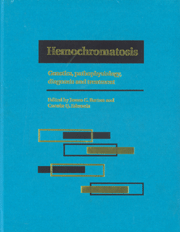Book contents
- Frontmatter
- Contents
- List of contributors
- Foreword
- Part I Introduction to hemochromatosis
- Part II Genetics of hemochromatosis
- Part III Metal absorption and metabolism in hemochromatosis
- Part IV Diagnostic techniques for iron overload
- Part V Complications of iron overload
- Part VI Therapy of hemochromatosis and iron overload
- Part VII Infections and immunity in hemochromatosis
- Part VIII Hemochromatosis heterozygotes
- Part IX Relationship of hemochromatosis to other disorders
- Part X Animal models of hemochromatosis and iron overload
- 47 β2-microglobulin-deficient mice as a model for hemochromatosis
- 48 Animal models of iron overload based on excess exogenous iron
- 49 Naturally occurring iron overload in animals
- Part XI Screening for hemochromatosis
- Part XII Hemochromatosis: societal and ethical issues
- Part XIII Final issues
- Index
48 - Animal models of iron overload based on excess exogenous iron
from Part X - Animal models of hemochromatosis and iron overload
Published online by Cambridge University Press: 05 August 2011
- Frontmatter
- Contents
- List of contributors
- Foreword
- Part I Introduction to hemochromatosis
- Part II Genetics of hemochromatosis
- Part III Metal absorption and metabolism in hemochromatosis
- Part IV Diagnostic techniques for iron overload
- Part V Complications of iron overload
- Part VI Therapy of hemochromatosis and iron overload
- Part VII Infections and immunity in hemochromatosis
- Part VIII Hemochromatosis heterozygotes
- Part IX Relationship of hemochromatosis to other disorders
- Part X Animal models of hemochromatosis and iron overload
- 47 β2-microglobulin-deficient mice as a model for hemochromatosis
- 48 Animal models of iron overload based on excess exogenous iron
- 49 Naturally occurring iron overload in animals
- Part XI Screening for hemochromatosis
- Part XII Hemochromatosis: societal and ethical issues
- Part XIII Final issues
- Index
Summary
Introduction
The purpose of an animal model of iron overload is to mimic hemochromatosis in humans. In hemochromatosis, excess iron accumulation in parenchymal cells of the liver results in toxicity, hepatic fibrosis and ultimately cirrhosis. Characteristically, the excess iron is initially deposited in periportal hepatocytes in hemochromatosis; with progression, hepatocytes across the entire acinus become heavily iron loaded. Although there is some Kupffer cell iron overload late in the course of iron loading, hemochromatosis is an iron overload disorder in which parenchymal cells are predominantly affected.
There are many models of iron overload, and they can be categorized into two main groups according to the route of iron administration. The first are enteral or dietary iron overload models in which carbonyl iron, ferrocene, and ferric ammonium citrate are administered to experimental animals. The second are parenteral iron overload models that involve administration of iron chelates such as iron–dextran, iron–sorbitol, or ferric nitrilotriacetate. Some have been proposed to represent the clinical and physiological manifestations of hemochromatosis. Some mimic the pattern of iron accumulation of hemochromatosis. A few induce hepatic fibrosis. Most do not faithfully reproduce all of the pathophysiologic characteristics of hemochromatosis. However, they provide experimental systems in which to examine the pathways of iron metabolism and to study the toxic effects of excess iron on normal physiology. This chapter discusses the pathophysiologic consequences of excess hepatic iron and outlines the different animal model systems used to study the pathophysiology of iron overload and its relationship to hemochromatosis.
- Type
- Chapter
- Information
- HemochromatosisGenetics, Pathophysiology, Diagnosis and Treatment, pp. 494 - 507Publisher: Cambridge University PressPrint publication year: 2000
- 1
- Cited by



